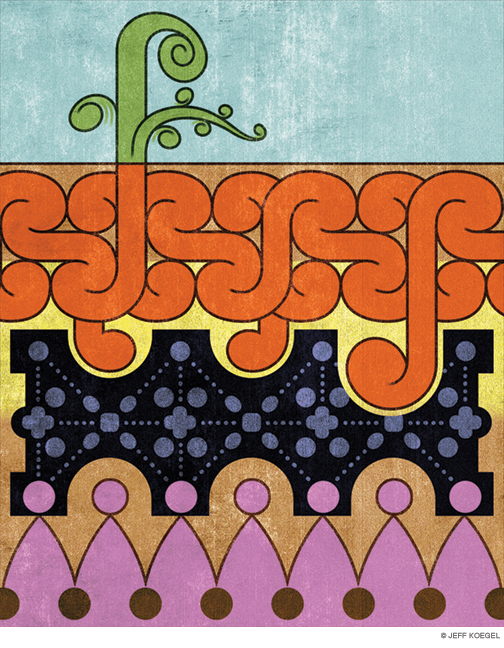
Discovering the soul of democratic education in Aotearoa, New Zealand.
By Joshua Block
My work as a teacher in Philadelphia frequently reminds me that school should encourage young people to take risks while they are challenged to examine themselves, their roles, and the potential for their voices to shape the world. But it took traveling 9,000 miles for me to really understand how schools can profoundly impact students’ understandings of themselves.
Early on during a Fulbright fellowship in Aotearoa, New Zealand, I was preparing a presentation for the faculty of a secondary school. I shared some of my ideas with my local mentors, seeking feedback. Among the recommendations they offered was one piece of advice that caught me by surprise: I should prepare a mihimihi—a traditional Ma¯ori greeting—to begin the presentation. And not only should I kick off my presentation in the indigenous tongue, I should do so in a loud, booming voice!
I balked. Wouldn’t it be disrespectful to butcher a language I don’t know by speaking it in front of a group? In the US if I was to pretend to speak Lenape or attempt to pass as another ethnicity the results would be cringeworthy. What good could possibly come from imitating a culture to which I plainly did not belong? Yet I was reassured that this would in fact be seen as honoring Ma¯ori culture—and that even just making an attempt, even if it wasn’t entirely successful, would be seen as respectful.
So I began writing my mihimihi, learning from others the proper way to place myself in context for the audience: by describing the mountain I identify with, the body of water I identify with, the name of my hometown, and my name. Having lived in Philadelphia for some time, I was amused by the realization that I was about to fully embrace my connection to the Schuylkill River, and that the sides of the Wissahickon Valley were the geologic formation closest to my home that resembled a mountain.
The day of the presentation, I was introduced by the principal and stepped forward to begin:
Te¯na¯ koutou, te¯na¯ koutou, te¯na¯ koutou katoa …
[Greetings, greetings, greetings all …]
The majority white, mostly non-indigenous teaching staff sat attentively, listening closely. I was in a situation where the rules had changed. The norms required the dominant culture to step back and prioritize an indigenous practice despite the fact that it was not necessarily within a zone of comfort for many in the room.
The discomfort I felt is a reminder that for many students, school success requires them to conform to the standards and values of others. Many students experience school as a series of lessons about the necessity of submerging their primary identities or family cultures in order to succeed academically. Whether those identities are rooted in the experience of growing up working class, navigating the city as a person of color or first-generation immigrant, being a queer youth, or a multitude of other experiences, the unspoken message is too often that there is no place for their full identities in school. Success, these children are taught, depends on accepting that the path through school—and society—is easier if you suppress marginalized identities and instead conform to mainstream cultural standards. Students and families are often put in the situation of prioritizing either school values or home values, since there is no pathway for merging the two.
Students need tools to navigate a range of spaces throughout their lives. Demanding that they conform to one standard serves to silence and negate aspects of their identities while setting the stage for endless struggles over compliance. Whether this happens by design or by default, the result is that many students experience school learning as something external to who they are and what matters to them. In contrast, it is possible for teachers to create spaces and experiences for students that allow them to explore social complexities and power dynamics even as they examine and express their own cultural diversity and individuality. This is what educator and author Carla Shalaby so beautifully describes as qualities of free people: “A free person retains her power, her right to self-determination, her opportunity to flourish, her ability to love and be loved, and her capacity for hope.” These qualities, which are part of the essence of being human, should not be negotiated or denied within the walls of schools.
There is extensive racism in New Zealand and there are pressing social issues. Yet I was inspired by the ways many people from a broad range of backgrounds spoke of the need to build a more equitable society. Even small symbols, such as government signs that include indigenous Ma¯ori names alongside English ones, served as reminders of biculturalism and the legacy of colonialism. Every school I visited, even if it served primarily white students, contained examples of indigenous Ma¯ori art and language. The nation’s legal framework acknowledges that there is more than one culture and value system, a reality reflected in the practice of referring to the country by its indigenous and colonial names—Aotearoa, New Zealand—and one that is manifest in educational policy. The Ministry of Education explicitly emphasizes a goal that “all Ma¯ori students gain the skills, qualifications, and knowledge they need to succeed and to be proud in knowing who they are as Ma¯ori.”
An emphasis on providing students from all backgrounds with opportunities to reclaim and sustain their cultures and who they are shifts the experience of school. It makes learning less about fulfilling external requirements and more about investing in a process central to one’s current and future identity.
The idea of providing students opportunities to succeed as themselves is a concept that continues to inform my work with young people in Philadelphia. An example is my students’ Our Philadelphia, Our America projects. The range of work has included a multimedia essay examining the reality of navigating the city from the perspective of a legally blind recent immigrant from Algeria, a day-in-the life narrative from a student who paired excerpts from Walt Whitman with descriptions of the challenges of being a student and working many hours in a retail setting, and fierce writing from a young woman who was regularly catcalled by men in her neighborhood. These types of projects create moments when students discover and hone the language to define their own realities. School is no longer about becoming someone else in order to succeed academically. The emphasis shifts and a collaborative, intellectually creative environment is built. Students are eager to revise their work, hoping to produce high-quality products that will be shared with and celebrated by their classmates and seen by wider audiences once they are published on the project website.
Ultimately this is what it means to teach in a democracy and for a democracy. If we offer simplistic learning experiences, the results will be irrelevant to students’ lives and fail to respond to the full breadth of our society as it actually exists. Instead, teachers can infuse classrooms with opportunities to engage complexity, knowing that the outcomes will sometimes be unpredictable, but that the results have the potential to transform students and society.
Joshua Block C’96 GEd’01 CGS’03 is a public high school teacher in Philadelphia and the author of Teaching for a Living Democracy: Project-Based Learning in the English and History Classroom (Teachers College Press. Copyright © 2020 by Teachers College, Columbia University), from which portions of this essay are adapted by permission of the publisher.




